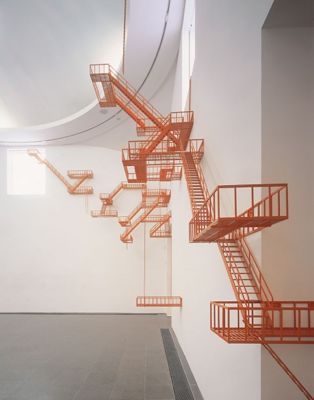
Sarah Sze, “Second Means of Egress (Orange)”, 2004. Courtesy the artist and Tanya Bonakdar Gallery, New York
In each of our new season 6 episodes, not to mention throughout the entire Art21 series, there are superb quotes to share with students, colleagues and friends as kickstarters for discussions, assignments- even as a way to challenge assumptions we make in our work as artists and educators. This week I want to highlight a few quotes from the Balance episode and reflect on some of what each quote can inspire or teach, even across disciplines. During the summer I will then revisit the “Kickstarters” posts to focus on other quotes from the remaining episodes.
Here goes…
I don’t think of myself as being a landscape painter. In the popular envisioning of that term, a landscape consists of a painting with a field and a pond and a tree and a mountain in the distance, etc. It’s a sort of recipe thing. I hope very much that my paintings don’t look like recipe paintings, that I’ve gone to other places and seen something different. – Rackstraw Downes
What I like most about this quote is that Downes reminds us that he goes to “other” places for inspiration, which is essentially what we ask of our students on a regular basis. He makes clear that he has seen “something different” and wants to share this vision. He also gets to remove the box that a description like “landscape painter” may very well put him in. As teachers, we want our students to look beyond the obvious and at details in order to make sense of the complexity that comes with seeing a bigger picture. We want them to cultivate an individuality that steers clear of most labels.
I like setting up problems for the viewer and that viewer isn’t someone detached from me. I’m the viewer. I’m the first viewer. – Robert Mangold
The power of using this quote by Robert Mangold comes from re-visioning who the “viewer” actually is. If the artist is the first viewer then the effect a work has on the artist can inform how to shape the work for others to experience. Mangold also emphasizes “setting up” problems and intentionally giving himself something to figure out in order to learn something new. Think about how different some assignments would be if we simply asked, “So what kind of problem are you setting up for yourself here?”
My whole body of work has this kind of flexible, mutable quality. It has the rawness of a studio, or the rawness of a laboratory where things could happen, where things could fall apart. – Sarah Sze
As Sarah Sze discusses her work, she spotlights how many artists today are making art that is elastic in some way. But she is also talking about taking risks, which we emphasize is a big part of learning in all disciplines. Taking a chance where in fact things CAN fall apart simultaneously holds the promise of, “What can we learn if it doesn’t?”
Until next week…



